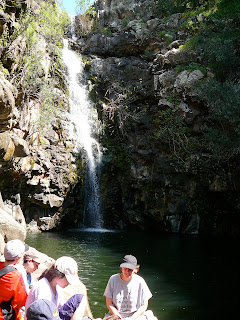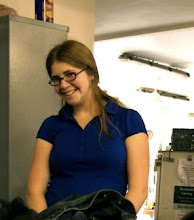A few memories:
February 2001: I am barely 14, and traveling Israel with my grandparents and their synagogue not so many months before the 2nd Intifada breaks out. We are driving in our tour bus to Jericho, and while we are stopped (because of traffic? a stop light? a check point?), I see Palestinian soldiers? policemen? (it's doubtful that I even knew who they were at the time). They are wearing militaristic uniforms, they are marching, they are holding guns. I snap a quick photo through the bus window, and one of the policemen/soldiers sees me. He angrily shakes his finger, "NO!" I am scared, in my rational 8th grade mind, that somehow this is going to have serious consequences for our entire tour group, and I don't say a word to anyone.
Spring 2003: I eat up the stories that I learn on EIE about the Israeli military. They are my heroes. I wear the dogtags of missing soldiers around my neck. I spend 5 days in Gadna, the Israeli Defence Forces' high school pre-army program. I (briefly) consider making aliyah and enlisting in the IDF. And plus...the soldiers are SO hot.
August 2009: I step out of the Central Bus Station, back in Jerusalem for the first time in two years. There are soldiers everywhere, and for the first time, I realize that they are young, and almost look as if they are dressed in costumes. My heart aches for them, for the world in which these young people are carrying guns, while my brother, their peer, is pursuing his dreams at college.
This past Friday: I am in a Palestinian-owned olive orchard in the northern part of the West Bank. A Jeep full of Israeli soldiers pulls up next to us. My stomach clenches; I am scared.
~~~~~~~~
To back up a little...this past Friday, I went with
Rabbis for Human Rights to participate in the Palestinian olive harvest. For the past 15 years or so, this organization has been accompanying Palestinian farmers to their olive trees, in places where those olive trees butt up against Jewish settlements. The volunteers with Rabbis for Human Rights are an international presence, and are able to place calls to the police and to the army to report crimes committed by settlers that, in theory, are more likely to be answered than if the call were to be placed by the Palestinians themselves.
After waking up incredibly early (we met up at SIX IN THE MORNING!), we were dropped off in small groups near the trees we would be harvesting. We were warned that there had already been some trouble with settlers illegally trespassing through Palestinian fields, armed with photocopies of an IDF order saying that Palestinians have the right to harvest every olive off of every tree, and told to keep a low profile and not attract extra attention from the army. There's a map of the area where I was
here.
Along with a classmate, a friend, and two others, we were matched up with Jamal and his family - his wife and five of his six children were out that day to pick olives, the first day of the season for them. Jamal spoke Hebrew, so we were able to talk about his family and who owned the trees and how the olives fit into the economy. Jamal's aunt owns the trees themselves, but doesn't work the land anymore, so she gets about 30% of the profits and Jamal's family takes the rest. They harvest the olives, press their own olive oil, and Jamal's wife brines olives (fun fact: olives are NOT edible straight off the tree) at home. Picking itself was lots of fun - it was good to be outside, especially now that the weather is significantly cooler here, to be physically active climbing on trees. The kids were cute and wanted to play. Many of the residents of the nearby Palestinian town of Awarta were out harvesting their olives that day, families riding by on donkeys or packed into cars, greeting each other and having fun. My suburban self was thrilled with a little glimpse of rural life.
And then the soldiers pulled up. It was a moment - to be fair, not the first time I have had this moment. It happens often when I am at Women of the Wall (which I missed by going to the olive harvest!) - when the Israeli army ceased to be the friendly presence I looked up to in middle school and high school, and became...the enemy. Even though that word still feels too strong to use. This area was closed to us, we were told in English. We needed to leave. "You, you're
b'seder g'mur (totally OK)," the soldier explained in Hebrew to Jamal and his family. We called the RHR staff who were with us, much more well-versed in these matters. "They need a signed order to throw you out." Well, they had a piece of paper with a lot of Hebrew and a signature on it...and anyway, our transportation wasn't returning for another 2 hours! So we told them we were staying...To be honest, at this point, I am scared. I am not a law-breaking, let's get arrested for the sake of social change type of activist. I'm a community organizer, who likes to take it to the streets every now and then to spice things up. And where I come from, you don't defiantly ignore the Israeli army.
The soldiers kept driving by throughout the day, sometimes slowing down and looking at us, sometimes stopping the Jeep for several minutes. My classmate shared a cigarette with one soldier, he gave her a chocolate pudding in return. Why did they want us out of there so badly? To protect the Palestinians? To protect the settlers? Nope. Because it was Friday afternoon, and they wanted to go back to their base to nap, and they couldn't until after we left.
Lunchtime rolled around. Jamal's wife and older daughter had cooked lunch over a little camp stove - eggs, potatoes, hummus, pickles, laffa (big flat pita), all of it drenched in delicious olive oil. The olive oil, the pickles, and the laffa were ALL homemade, and delicious.
We picked some more olives, and soon it was time to leave, in order to return to Jerusalem before Shabbat. As we drove to pick up the other small group, the skies opened up and it POURED - for the first time! The first rain of the rainy season is something to be celebrated (and appreciated, especially after spending a day outside harvesting). When we reached the second (now soaking wet) group, we learned that a group of settlers had found some ladders in a Palestinian olive orchard, stolen them, and thrown them into an empty well.
How useful is this, accompanying Palestinians to do the olive harvest? Clearly, it doesn't create systemic change - it doesn't change army policies or settler behavior. The organization's been doing this, with many of the same families, towns, settlements, for 15 years! That aside, clearly, the olives need to be picked this year, even if the policies don't change this year, and if having another group present will help diffuse some of the tensions or provide witness to some of the stupid crap (stealing ladders, burning olive trees, trespassing through private property) that happens, then I am glad and honored to take part (especially if I get to eat such delicious food). Yet the question that I am still wondering about -
is our presence just drawing more unnecessary and unwanted attention to the harvest, from both the army and the residents of the surrounding settlements?
Olive trees are such a potent symbol. They are one of the seven species of the Land of Israel (7 plants identified biblically as being native to the Land), and everyone, everywhere associates them with peace. And for these Palestinian farmers, they're also a livelihood. Going out and doing work like this, even though it is complicated, makes me feel like a more complete person, rather than just the part of me who sits in class. When I got back to Jerusalem that Friday afternoon (to see even more rain!), I felt that much more ready to celebrate Shabbat, although this was probably also because it was the first week in a month when there hadn't been any holidays.
















